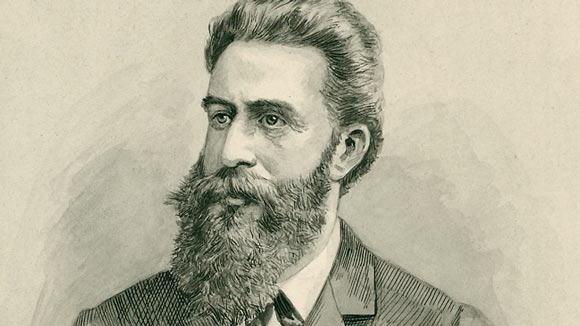Wilhelm Röntgen invented “X-Ray Machine”.
Wilhelm Conrad Röntgen was a German scientist, best known for his discovery of X-rays and being the recipient of the first Nobel Prize in Physics. Röntgen was an only child, born in 1845 to a cloth merchant. As a child, he showed no remarkable aptitude towards science, although he was fond of nature and loved to explore the outdoors. Röntgen attended boarding school in his youth, and in 1862 he joined a technical school at Utrecht. However, he was unfairly expelled from there and in 1865 he joined the Polytechnic in Zurich by passing the entrance examinations and enrolled there as a student of mechanical engineering. In 1869 he graduated with a Ph.D. from the University of Zurich. He was greatly influenced by the works of Clausius and Kundt, and went to Würzburg and later to Strasbourg to work with Kundt.
Röntgen held a number of teaching positions including Lecturer at Strasbourg University, Professor at the Academy of Agriculture at Hohenheim, Professor of Physics at Strasbourg, Chair of Physics at the University of Giessen, Professor at the University of Würzburg and Chair of Physics at University of Munich (a position which he accepted in 1900 and kept till the end of his career). He also declined several teaching positions including at the University of Jena in 1886, the University of Utrecht in 1888, and Chair of Physics at the University of Leipzig in 1899.
Röntgen carried out research in several fields including the thermal conductivity of crystals, how various fluids react to pressure, and temperature and compression of water and various other fluids but his main claim to fame is the discovery of X-rays (also sometimes known as Röntgen rays) in 1895. Wilhelm Röntgen was conducting an experiment by passing an electric current through a gas at extremely low pressure. During his experiment, he noticed that even though the room was dark and the tube was covered with black carbon, a screen covered with fluorescent material was being lit up. By placing a photographic plate at the other end, Röntgen was able to capture the image that was being lit up by these unknown rays. As Röntgen was unaware of the nature of these rays, he called them X-rays. The first X-ray ever taken was an image of Röntgen’s wife’s hand. When she saw the image, she exclaimed that she had seen her own death.
Röntgen’s discovery was a remarkable advancement in the field of medicine as it meant that it was possible to see inside the human body without actually having to cut it up and perform surgery. In 1901, Röntgen was awarded the first-ever Nobel Prize in Physics for his remarkable discovery. He published three papers on the subject and oversaw the establishment of the first radiology department at the Glasgow Royal Infirmary. The Head of this Department was Dr. John Macintyre and he produced a number of noteworthy images such as a penny stuck in a child’s throat and an image of a kidney stone. X-rays were also used to make medical diagnosis, for instance, Dr. Hall Edwards was the first person to do so after he discovered a needle stuck in a woman’s hand by conducting an X-ray of her palm. It was later discovered that frequent exposure to X-rays could be harmful and subsequently, protective measures were taken to protect both doctors and patients.
Wilhelm Röntgen never patented any of his discoveries and even donated the money from his award to the University of Würzburg. He married Anna Bertha Ludwig and adopted her brother’s daughter as his own child. Towards the end of his life, he fell into poverty and when he died in 1923, his personal belongings and scientific correspondence were destroyed as per the instructions given in his will.
